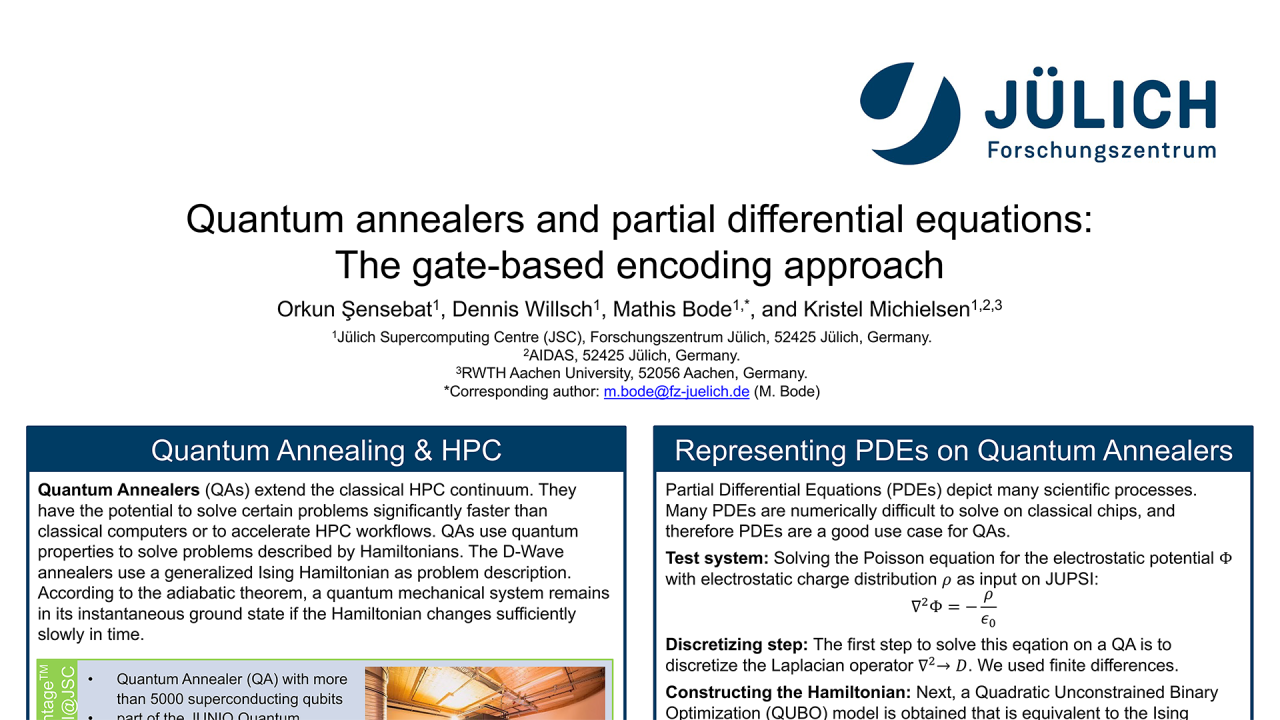

Quantum Annealers and Partial Differential Equations: The Gate-Based Encoding Approach
Monday, May 13, 2024 3:00 PM to Wednesday, May 15, 2024 4:00 PM · 2 days 1 hr. (Europe/Berlin)
Foyer D-G - 2nd floor
Research Poster
Integration of Quantum Computing and HPCQuantum Computing - Use CasesQuantum Program Development and Optimization
Information
Poster is on display and will be presented at the poster pitch session.
Representing Partial Differential Equations (PDEs) on Quantum Annealers (QAs) is not obvious. The first step of solving a PDE on a QA is to discretize it. We used finite differences. Next, a Quadratic Unconstrained Binary Optimization (QUBO) model is obtained that is equivalent to an Ising model. Finally, the QUBO coefficients are computed using an encoding in terms of the qubits to represent the variables. The conventional choice for this encoding is a binary encoding. A challenge is that the accessible size of systems is constrained due to the limited number of qubits. In other words, it becomes impossible to achieve a non-zero convergence probability. We addressed this challenge by developing a novel encoding, the gate-based encoding (GBE), to replace the conventionally used binary encoding. This aims to overcome the problem of exponentially scaling coefficients of binary encoding. GBE utilizes the structure of the discretized operators to construct a circuit that results in QUBO weights of comparative magnitude for each bit in the final bit-string, thus overcoming the exponentially rising weight given to the leading digits in the conventionally used binary encoding. GBE allows to successfully solve problems with larger encoding lenths for all problem sizes and solvers, e.g., 21 vs. 17 for the hybrid solver with our test setup. This is also emphasized by the significantly higher success probability for all encoding lengths compared to binary encoding. The cost of GBE is the higher number of variables (three extra variables per solution variable).
Contributors:
Representing Partial Differential Equations (PDEs) on Quantum Annealers (QAs) is not obvious. The first step of solving a PDE on a QA is to discretize it. We used finite differences. Next, a Quadratic Unconstrained Binary Optimization (QUBO) model is obtained that is equivalent to an Ising model. Finally, the QUBO coefficients are computed using an encoding in terms of the qubits to represent the variables. The conventional choice for this encoding is a binary encoding. A challenge is that the accessible size of systems is constrained due to the limited number of qubits. In other words, it becomes impossible to achieve a non-zero convergence probability. We addressed this challenge by developing a novel encoding, the gate-based encoding (GBE), to replace the conventionally used binary encoding. This aims to overcome the problem of exponentially scaling coefficients of binary encoding. GBE utilizes the structure of the discretized operators to construct a circuit that results in QUBO weights of comparative magnitude for each bit in the final bit-string, thus overcoming the exponentially rising weight given to the leading digits in the conventionally used binary encoding. GBE allows to successfully solve problems with larger encoding lenths for all problem sizes and solvers, e.g., 21 vs. 17 for the hybrid solver with our test setup. This is also emphasized by the significantly higher success probability for all encoding lengths compared to binary encoding. The cost of GBE is the higher number of variables (three extra variables per solution variable).
Contributors:
Format
On-site



